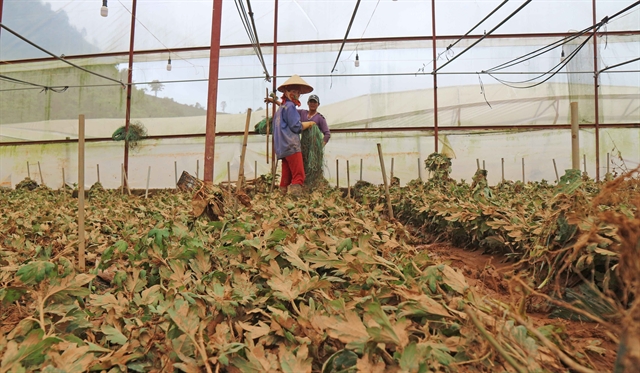 Society
Society

The installation of greenhouses for vegetable and flower farming in Đà Lạt should be strictly regulated to reduce their impact on the environment and landscapes, experts have said.

|
| A greenhouse was damaged by flooding in Lâm Đồng Province’s Lạc Dương District in August. — VNA/VNS Photo Nguyễn Dũng |
LÂM ĐỒNG — The installation of greenhouses for vegetable and flower farming in Đà Lạt City should be strictly regulated to reduce their impact on the environment and landscapes, experts have said.
The Tây Nguyên (Central Highlands) province of Lâm Đồng has 4,500ha of greenhouses, including more than 2,800ha in Đà Lạt.
Greenhouses have been popular in Đà Lạt since the late 1990s.
There are no official guidelines for the management of greenhouse construction or licensing and so there is no legal foundation for the management of greenhouses, according to the city People’s Committee.
Speaking at a recent seminar held in Đà Lạt, Trần Xuân Hiền, director of the province’s Centre for Hydro-Meteorology Forecasting, claimed the unplanned setting up of greenhouses has impacted the climate and the lives of local people.
The occurrence of floods in concentrated agricultural areas and the downstream areas of the Cam Ly and Phan Đình Phùng springs in recent years has been due to greenhouses covering a large area, which cannot absorb and drain water, leaving rainwater to flow directly into springs and causing the flooding, he said.
Trần Văn Việt, deputy chairman of the Lâm Đồng Architects Association, said in the past, greenhouses in the city were built in agricultural areas and valleys but have now been expanded to near springs and on the top of hills.
There is now a high density of them, he said.
To address the problems caused by greenhouses, it is necessary to have careful management and education of farmers on the effects greenhouses cause, he said.
There is a need for legal regulations and sanctions to curb the unplanned installation of greenhouses in urban areas, he said.
“Measure of collecting an environmental fee on greenhouses should be studied and policies should be issued.”
Besides being a famous tourism city, Đà Lạt also has 10,000ha of farmlands and favourable weather and soil conditions for developing high-tech agriculture.
Greenhouses help improve the yields and quality of vegetables and flowers and reduce labour and production costs since they can control the impacts of weather.
The city’s farmlands yielded an average income of VNĐ350 million (US$15,100) per hectare last year.
Greenhouses allow the use of technology in agriculture but it is not necessary to grow every plant in a greenhouse, Phạm S, deputy chairman of the province People’s Committee, said.
The province encourages the cultivation of high-value crops outside greenhouses, he said.
Đà Lạt should have sanctions to prevent the unplanned installation of greenhouses to balance economic benefits and environmental protection, he said.
The city would petition provincial authorities to issue regulations to ensure that greenhouses do not exceed 70-80 per cent of a farm, according to the city’s People’s Committee. — VNS








.jpg)
